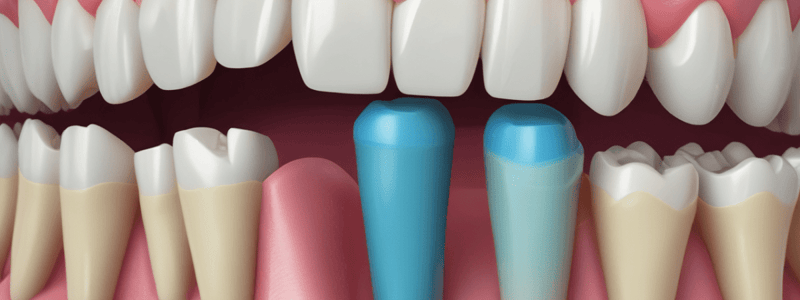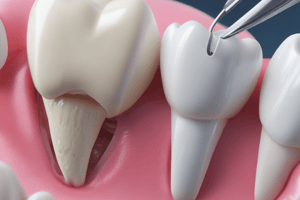Podcast
Questions and Answers
What is the first step in the initial tooth preparation stage?
What is the first step in the initial tooth preparation stage?
- Primary retention form
- Outline form and initial depth (correct)
- Convenience form
- Primary resistance form
Which of the following is NOT a step in the final tooth preparation stage?
Which of the following is NOT a step in the final tooth preparation stage?
- Removal of any remaining infected dentin or old restorative material
- Pulp protection, if indicated
- Secondary resistance and retention forms
- Primary retention form (correct)
What is the purpose of removing infected dentin during tooth preparation?
What is the purpose of removing infected dentin during tooth preparation?
- To increase the retention of the restoration
- To prevent further caries progression (correct)
- To improve the esthetics of the restoration
- To create space for the restorative material
What is the difference between infected and affected dentin?
What is the difference between infected and affected dentin?
Which step in the final tooth preparation stage involves finishing the external walls of the cavity?
Which step in the final tooth preparation stage involves finishing the external walls of the cavity?
What is the last step in the final tooth preparation stage?
What is the last step in the final tooth preparation stage?
What is the purpose of removing any remaining enamel pit, infected dentin, or old restorative material in the final tooth preparation stage?
What is the purpose of removing any remaining enamel pit, infected dentin, or old restorative material in the final tooth preparation stage?
When should remaining old restorative material be removed according to the text?
When should remaining old restorative material be removed according to the text?
What is the purpose of pulp protection in the final tooth preparation stage?
What is the purpose of pulp protection in the final tooth preparation stage?
Why is it essential to remove any old restorative material that may compromise the amount of needed retention?
Why is it essential to remove any old restorative material that may compromise the amount of needed retention?
Under what conditions should radiographic evidence prompt the removal of old restorative material in tooth preparation?
Under what conditions should radiographic evidence prompt the removal of old restorative material in tooth preparation?
What are the two primary features of finishing the external walls of a tooth preparation?
What are the two primary features of finishing the external walls of a tooth preparation?
Why is beveling contraindicated when using amalgam, except in specific cases?
Why is beveling contraindicated when using amalgam, except in specific cases?
Why is a 90-degree cavosurface angle recommended for materials like amalgam and ceramic?
Why is a 90-degree cavosurface angle recommended for materials like amalgam and ceramic?
In what specific case can a bevel be applied in a Class II tooth preparation?
In what specific case can a bevel be applied in a Class II tooth preparation?
What factor determines the design of the cavosurface angle in tooth preparations?
What factor determines the design of the cavosurface angle in tooth preparations?
Which of the following is true about the cavosurface margin in the final tooth preparation stage?
Which of the following is true about the cavosurface margin in the final tooth preparation stage?
When the tooth preparation has extended onto the root surface (no enamel present), what should the root surface cavosurface angle be for both amalgam and composite restorations?
When the tooth preparation has extended onto the root surface (no enamel present), what should the root surface cavosurface angle be for both amalgam and composite restorations?
Why is beveling of enamel margins in composite preparations indicated primarily for larger restorations?
Why is beveling of enamel margins in composite preparations indicated primarily for larger restorations?
What is the usual procedure for cleaning the tooth preparation?
What is the usual procedure for cleaning the tooth preparation?
Which of the following is a step in the final procedures for tooth preparation?
Which of the following is a step in the final procedures for tooth preparation?
When is beveling of the gingival floor of a Class II preparation indicated?
When is beveling of the gingival floor of a Class II preparation indicated?
What are the two types of secondary resistance and retention forms mentioned in the text?
What are the two types of secondary resistance and retention forms mentioned in the text?
Which instrument is recommended for removing any remaining enamel pit, fissure, infected dentin, or old restorative material?
Which instrument is recommended for removing any remaining enamel pit, fissure, infected dentin, or old restorative material?
What is NOT mentioned as a potential cause of pulpal irritation during or after operative procedures?
What is NOT mentioned as a potential cause of pulpal irritation during or after operative procedures?
Which type of restoration is associated with mechanical preparation features for secondary resistance and retention forms?
Which type of restoration is associated with mechanical preparation features for secondary resistance and retention forms?
What is the purpose of secondary resistance and retention forms in tooth preparation?
What is the purpose of secondary resistance and retention forms in tooth preparation?
What is the purpose of using a slow speed and air coolant during the removal of remaining material?
What is the purpose of using a slow speed and air coolant during the removal of remaining material?
Flashcards are hidden until you start studying




